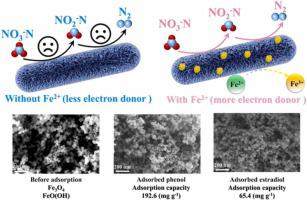Journal of Hazardous Materials ( IF 12.2 ) Pub Date : 2021-11-27 , DOI: 10.1016/j.jhazmat.2021.127918 Liang Xu 1 , Junfeng Su 1 , Amjad Ali 1 , Qiao Chang 1 , Jun Shi 1 , Yuzhu Yang 1

|
In this study, a nitrate–dependent ferrous (Fe2+) oxidizing strain under anaerobic conditions was selected and identified as XL4, which belongs to Aquabacterium. The Box–Behnken design (BBD) was used to optimize the growth conditions of strain XL4, and the nitrate removal efficiency of strain XL4 (with 10% inoculation dosage, v/v) could reach 91.41% under the conditions of 30.34 ℃, pH of 6.91, and Fe2+ concentration of 19.69 mg L–1. The results of Fluorescence excitation–emission matrix spectra (EEM) revealed that the intensity of soluble microbial products (SMP), aromatic proteins and the fulvic–like materials were obvious difference under different Fe2+ concentration, pH, and temperature. X–ray diffraction (XRD) data confirmed that the main components of bio–precipitation were Fe3O4 and FeO(OH), which were believed to be responsible for the adsorption of phenol and estradiol. Furthermore, the maximum adsorption capacity of bio–precipitation for phenol and estradiol under the optimal conditions were 192.6 and 65.4 mg g–1, respectively. On the other hand, the adsorption process of phenol and estradiol by bio–precipitation confirmed to the pseudo–second–order and Langmuir model, which shows that the adsorption process is chemical adsorption and occurs on the uniform surface.
中文翻译:

硝酸盐依赖性亚铁 (Fe2+) 氧化性水生细菌的反硝化性能。XL4:苯酚和雌二醇生物沉淀的吸附机制
本研究选择了厌氧条件下的硝酸盐依赖性亚铁(Fe 2+)氧化菌株,鉴定为XL4,属于水杆菌属。采用Box-Behnken设计(BBD)优化菌株XL4的生长条件,在30.34 ℃、pH条件下,菌株XL4(接种量为10%,v/v)的硝酸盐去除率可达91.41%。为 6.91,Fe 2+浓度为 19.69 mg L –1。荧光激发-发射矩阵光谱(EEM)结果表明,在不同的Fe 2+下,可溶性微生物产物(SMP)、芳香蛋白和类黄腐物质的强度存在明显差异。浓度、pH 值和温度。X 射线衍射 (XRD) 数据证实,生物沉淀的主要成分是 Fe 3 O 4和 FeO(OH),它们被认为是吸附苯酚和雌二醇的原因。此外,在最佳条件下,生物沉淀对苯酚和雌二醇的最大吸附量分别为 192.6 和 65.4 mg g -1。另一方面,生物沉淀对苯酚和雌二醇的吸附过程证实了准二级和朗缪尔模型,表明吸附过程是化学吸附,发生在均匀的表面上。











































 京公网安备 11010802027423号
京公网安备 11010802027423号